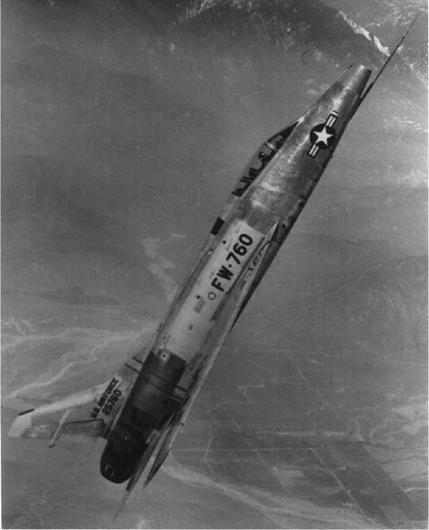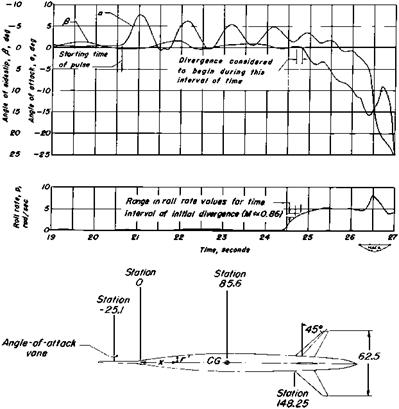The First Flight Occurrences
According to NACA, inertial coupling was first experienced in manned flight by NACA test pilot Joe Walker on the Douglas X-3 research airplane. However, Norman Bergrun and Paul Nickel of the NACA Ames Aeronautical Laboratory had made an earlier flight confirmation of the Phillips theory (1953). They found proof of the theory in the motions of an unmanned rolling body-tail combination tested at NACA’s High-Speed Flight Station at Edwards, California. As with the Douglas Mark 7 bomb test, the Bergrun-Nickel model diverged in angle of attack and sideslip when the spin or roll rate agreed with the model’s natural frequency in pitch and yaw (Figure 8.3).
While NACA engineers were still studying the X-3 flight records, inertial coupling occurred again, at NACA’s Flight Station in California. This was in mid-1954, on a North American F-100A Super Sabre being flown by a NACA research pilot. With two-thirds of full aileron, angles of attack and sideslip diverged and the airplane became uncontrollable (Seckel, 1964).
|
Figure 8.3 First flight confirmation of the Phillips inertial coupling theory, made on a rolling body – tail combination. A divergence begins at a roll rate of 3.5 radians per second. (From Bergrun and Nickel, NACA TN 2985, 1953) |
The F-100 was a prime candidate for inertial coupling, with very thin (7-percent thick) wings swept back at 45 degrees. Roll inertia was less than 20,000 slug-feet squared, compared with pitch and yaw inertias of 66,000 and 81,000 slug-feet squared, respectively. There was no artificial yaw or pitch damping. The pilot had plenty of control authority for making rapid rolls, with powered controls all around and simple spring artificial feel systems.
The F-100 was just going into service, and Air Force pilots encountered inertial coupling, as well. Several airplanes were lost and the Air Force grounded the fleet. North American engineers under the direction of the late John Wykes found in analog simulation of the F-100 that, in agreement with the principles laid down by Phillips, an increased level of static directional stability reduced the coupling. Yaw damping alone was found to make little improvement. Larger vertical tails fitted to the F-100A, F-100C, and later versions increased yawing natural frequency, reducing inertial coupling in rolls enough to allow the planes to return to service (Figure 8.4).
By coincidence, larger vertical tails were needed for the F-100 anyway, to prevent static directional instability in supersonic dives. Beyond a Mach number of 1, the static directional stability contribution of the vertical tail was reduced because of the normal reduction in lift curve slope at increasing supersonic speeds. In addition, at all high


 |
F-IOOA LARGE TAIL
M = 1.26, hp = 40,000 ft
—— STEAOY STATE
—— 5 DEGREES OF FREEDOM. 360* ROLLS
Figure 8.4 The effect of enlarging the F-100A vertical tail. The enlarged tail postpones side-slip angle divergence in rolls from roll rates of about 75 degrees per second to about 180 degrees per second, still not a very good rate. The agreement between the solid and dashed lines shows that the Schmidt-Bergrun-Merrick steady-state analysis method is a reasonably good predictive tool. The photo is of the F-100F, a late model that has the large vertical tail. (From Schmidt, Bergrun, and Merrick, WADC Conf. 56WCLC-1041, 1956)
airspeeds aeroelastic bending and torsion further reduced the fin’s contribution to directional stability.
The F-100’s inertial coupling problem illustrates a particular finding in Phillips’ 1948 analysis. Coupling is most severe when there is a large discrepancy between the levels of static longitudinal and directional stabilities, as shown by their respective natural frequencies. With its original small vertical tail, F-100 yaw natural frequency was particularly low. The reverse was true for the XS-1 drop model, whose flight-recorded oscillations led to the Phillips analysis. The XS-1 model had low pitch and high yaw natural frequencies at transonic speeds.
The Phillips inertial coupling charts show there is a window of stability for the case in which the natural frequencies are equal and there is some damping on each axis. Richard Heppe checked the variations of pitch and yaw natural frequencies for the Lockheed F-104 with airspeed, altitude, and loading, with discouraging results, as follows:
Maintenance of equal natural frequencies in pitch and yaw over wide speed and altitude ranges by aerodynamic means only will not be possible generally for practical airplane configurations. This implies that satisfactory roll response will become more difficult to obtain the wider the speed-altitude spectrum of the aircraft.












